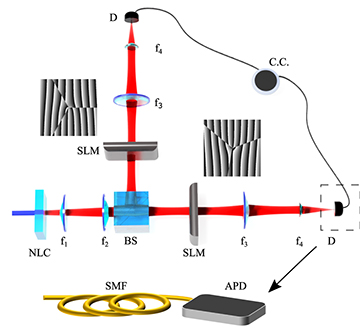![]()
Isaac Nape (University of the Witwatersrand, South Africa) and colleagues have devised a new hologram-based technique to measure entanglement dimensions fairly easily and quickly. [Image: Wits University]
The ability to entangle photons in high-dimensional states could improve both the security and capacity of quantum communication. But scientists currently struggle to measure entanglement purity and dimensionality in a reliable yet straightforward way. Now, an international group of researchers has come up with what it describes as a “simple, fast and direct” technique for determining these quantities. The team has demonstrated its approach experimentally, over a wide range of noise levels (Nat Comms, doi: 10.1038/s41467-021-25447-0).
Complicated by noise
Entanglement is a uniquely quantum phenomenon that correlates two particles, such that a measurement on one instantaneously fixes the state of the other no matter how distant it is. Dimensionality in such a system refers to the number of unique possible outcomes, which depends on the property used to do the entangling. Polarization, for example, would be limited to just two dimensions of entanglement, while structured light could have many more.
Measuring these dimensions is complicated by noise, which degrades the quantum signal and can diminish the number of useful dimensions. Overcoming such harmful effects has to date proved a headache for scientists, who have developed a number of measurement techniques—each with its own advantages and disadvantages.
Quantum state tomography, for example, yields information about the number of dimensions bit by bit, just as medics might employ computer tomography to create three-dimensional images of people’s bodies by combining a series of two-dimensional slices. But the sheer quantity of information involved makes the process extremely time-consuming. A quicker alternative is to carry out a Bell-state measurement. But while such measurements provide a definitive verdict on whether or not the particles are entangled, they convey few details about dimensions.
Speeding up via interference “visibility”
In the latest work, a team led by Andrew Forbes of the University of the Witwatersrand, South Africa, and colleagues from the United Kingdom and Taiwan has devised a new scheme that yields detailed information on both a system’s dimensionality and purity—even though the number of measurements involved scales only linearly with these quantities. It does so by recording the “visibility” of interference measurements between two particles that are entangled in multiple dimensions.

Schematic of the experimental setup. NLC, non-linear crystal; f1, f2, f3, f4, lenses; BS, 50:50 beam splitter; SLM, spatial light modulator; D, detector; APD, avalanche photodiode coupled to a single-mode fiber (SMF); CC, coincidence counter. [Image: I. Nape et al., Nat. Commun. 12, 5159 (2021); CC-BY 4.0]
Forbes and colleagues demonstrated the scheme using entangled pairs of photons generated in a nonlinear crystal. They passed each photon through a hologram created using a spatial light modulator, encoding it with orbital angular momentum (OAM), the degree to which a beam’s wavefront is twisted around its direction of propagation. They then coupled the photons into single-mode fibers and recorded whether or not the particles arrived simultaneously at a coincidence counter.
By varying the OAM superposition states and recording the probability of coincidence for each new set of states, the researchers were able to build up a series of quantum interference fringes. Each fringe has its own visibility, which is a measure of how clear (or blurred) it is.
“Quantum Cluedo”
Forbes says that these visibilities hold a huge amount of information, providing answers to many questions at the same time about the state being probed. He likens the tool to a quantum version of the game of Cluedo (known in North America as Clue). “If you guess Professor Plum in the bathroom with the candlestick,” says Forbes, “then the visibilities tell you how many of your guesses are right.”
In contrast to the board game, in the world of quantum Cluedo the number of characters, rooms and weapons is unknown. But, Forbes maintains, by comparing visibility answers and looking for overlap between them, it is possible to accurately extract the required information—in this case, measures of entanglement dimensionality and purity.
Forbes and colleagues argue that the tool should work regardless of the quantum state being tested. To show this, they carried out an experiment involving states with a wide range of dimensions—up to as many as 100—and and under various noise conditions. They also found that it works regardless of how the quantum data are encoded, demonstrating it using variations in position as well as OAM.
A gain in simplicity
Lead author Isaac Nape acknowledges that the approach has its limitations. For one thing, it has only been tested against one particular form of noise, common white noise. Nevertheless, Nape says the use of easy-to-build holograms and the measurement of visibilities makes the approach far less complex than tomography.
Forbes says that they are not looking to replace rival techniques but rather complement them, explaining that the full tomography can always be carried out afterwards in order to obtain all the information on the quantum state. As he puts it, the different approaches provide “horses for courses.” One application where the group’s scheme might be particularly well suited, he adds, is the measurement of noise and its impact on entanglement dimensions in real-world quantum communication links.
